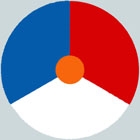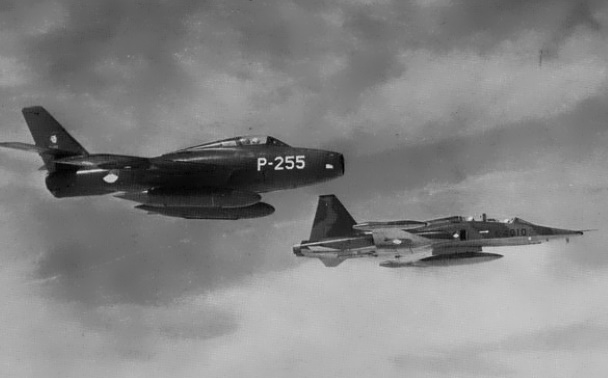 Credit: Roundels of the world
Credit: Roundels of the worldRoundel Last update 10-10-22
Koninklijke Luchtmacht - Royal Netherlands Air
Force
 Credit: Roundels of the world
Credit: Roundels of the world
Roundel
Last update 10-10-22
Procurement
The Netherlands and Belgium had a
joint flying instruction programme whereby cadets trained first on
Belgian Fouga Magisters, followed by advanced training on Dutch
Lockheed T-33A and operational conversion on
Dutch Republic F-84F, but
replacement for these aged aircrafts was needed by the mid-60s.
An evaluation team was sent between
10-01-66 and 05-02-66 to the USA to evaluate various aircrafts: LTV
A-7A, Northrop F-5A, Douglas A-4E and Lockheed CL-984 (a strike version
similar to the F-104S).
None
of these was selected; the choice fell on the Canadair
version of the Freedom Fighters to be built partially in the
Netherlands, designated Canadair NF-5A and
NF-5B (Canadair
designation CL-226-1A10 and
CL-226-1A11), respectively single- and
double-seaters. This aircraft enabled the replacement of several types
in Dutch use: the Republic F-84F Thunderstreak fighter-bomber, the
Republic RF-84F Thunderflash
reconnaissance-fighter and Lockheed T-33A
trainer.
Improvents
to the Canadair aircraft over the basic Northrop F-5 were manoevring
capability at all speed, installation of armour plate below the cockpit
area and over critical hydraulics and control sytem components;
installation of an arrester hook
to prevent overrun, provision of 2 or 4 JATO bottles to reduce the
take-off run. The inboard external stores hard points might be
strengthen to hold a 1'040 liter tank instead of the
568 liters standard tank.
Jettisonable underfuselage and underwing pylons were standard in the
the Canadian version. All modifications are shown hereunder.

The choice was officially announced on 25-10-66 by the Defence
Minister. Unfortunately Belgium did not agree to replace its own
Republic F-84F with the same aircraft, preferring to order Mirage 5 built under licence
locally.
Dutch aircrafts were essentially
similar to the Canadian AF CF-5 but
introduced several modifications, the most important were: more
powerful
J-85Can-15 engines, Doppler radar navigation system, arrester hook, a
strengthened windscreen; NF-5A only had provison for 1040 liter wing
pylon tanks and
a two position nose gear.
An
order for 105 aircrafts was placed on 30-01-67; Aviolanda was to
assemble locally the rear fuselage, Avio Diepen the centre fuselage,
complete assembly being undertaken in Canada
at Montreal by Canadair.
Plans were to manufacture 50 Canadair NF-5A
for 2 fighter-bomber Squadrons, 25 reconnaissance NF-5A for 1
Squadron and 30 NF-5B trainers to replace 35 Lockheed T-33As.
Finally, it was decided to order 75 fighter-
bombers and 30
double-seaters
for 3 operational Squadrons and 1 advanced training/operational
conversion Squadron.
The
first NF-5A built was rolled out by Canadair
on 05-03-69 and first flew on 24-03-69, followed by the first NF-5B on
07-07-69; two NF-5s entered the flight test programme by May 1969 while
24 Dutch technicians
were trained as technical instructors.
First Canadair NF-5A (serial K-3001) and three NF-5B were officially handed-over to the Air Force on 08-10-69
at Montreal-Cartierville
plant; K-3001 left shortly after for Edwards AFB (USA) to be used for tests.
 Photo: Canadair
Photo: Canadair
Initial Canadair NF-5B K-4005,
K-4006, K-4001 on a test flight.
Very last aircrafts to reach Dutch soil were NF-5A K-3071 and NF-5B K-4030 on 20-03-72 with "Hi-flite" Nr 20A.

 Photo: via Ed van't Hoofd
Photo: via Ed van't Hoofd
Republic F-84 F and an early Canadair NF-5ACanadair NF-5B
K-3302 seen
at Soesterberg AB on an icy day, in early colours, without badge
Initially
the NF-5 training unit operated as Transitie Vliegopleiding (TVO) at
Woendsrecht AB; Squadron 315 took over in May 1970 training duties, when
enough
aircrafts were available.
Camouflage
All Dutch NF-5s were delivered in standard camouflage and this was kept for a long time. In the mid-80s three new camouflages were experimented: grey only, a two-tone
grey/blue, and a so-called "F-16". The grey
only was finally selected and
applied to several aircrafts, see serial list for details.
 Photo: Archive The
Northrop F-5 Enthusiast
Photo: Archive The
Northrop F-5 Enthusiast
Canadair NF-5B K-4011, 316 Squadron, with long-range tanks, in original
coulours in Italy on
29-09-1985.


Canadair
NF-5A K-3036, 314 Squadron in definitive all-grey colour seen in November 1987.
Canadair NF-5A K-3028, 315 Squadron seen on July 1984, in "F-16"
camouflage. Note coloured tail-badge;
Photo: Charles Stewart this
was by 1985 toned-down, see picture in "Units" page.
Photo: Jos Wigbold


Dense light on newly in two-towne grey/blue painted Canadair NF-5A K-3030, without
Squadron
Grey/grey Canadair NF-5B K-4014 of 313s Squadron seen in-flight with
three tanks.
badge. The aircraft is fitted with four underwing pylons, with two tanks. Photo:
unknown
Photo R. Netherlands AF
Utilisation
The
aircrafts were used during their Dutch career mainly in the
fighter-bomber role (apart from training), flying low-level missions
against troops and ground installations. The Vliehors range, on the
same name island,
as utilised for weapons training.
Bodo AB in Norway was a regularly used for the fighter-bomber excercises in the 1980s.
They
were also used as day only interceptors (due to lack of radar), armed
with AIM-9J, Sidewinder for a few months at the beginning of 1982,
during an interim period between the phase-out of Lockheed F-104G and
the operational introduction of the General Dynamics F-16.

Canadair NF-5A
K-3056 belonging to the 313 Squadron in new grey camouflage and
armed with
inert AIM-9J Sidewinders, blue painted.
Dissimilar air-combat training was also exercised; in the early years the under-fuselage tank was painted with two red bands, later a panel was painted either in red, white or yellow colours on the aircraft used.
 Photo: Archive The Northrop F-5 Enthusiast
Photo: Archive The Northrop F-5 Enthusiast
Sometimes only two red bands plus
the nose of the under-fuselage tank were painted in red, as seen here in December 1977.


Canadair NF-5A K-3014, 316 Squadron, with red panel and AIM9-J used for dissimilar training Canadair NF-5A
K-3017, 316 Squadron, with white panel used for dissimilar training seen in
August 1980.
seen in June 1990.
Photos: Archive The Northrop F-5 Enthusiast
Reinforcement
of the wings and the stabilisators were introduced to the
aircrafts at the end of the 1980's to keep them flying till their final withdrawal.
 Photo: RNAF
Photo: RNAF
Two Canadair NF-5A in latest colours, tanks in old and new colours
together with their General Dynamics F-16A replacement.
Withdrawal
An USA offer in 1975 regarding replacing Lockheed F-104G with a less sophisticated/expensive Northrop F-5E was
rejected due to the wish to maintain an European aircraft industry; the
General Dynamics F-16 was
finally chosen over the Mirage F.1.
Aircrafts withdrawn from General Dynamics F-16 re-equipped Squadrons were initially attached to 316 Squadron. At a later stage, due to the high number, to a specially formed unit:
Vliegend Uit Dienst (VUD) at Gilze-
Rijen
AB, later Woendsrecht AB; first definitive retirement was on 27-03-86,
when NF-5A serial K-3057 was withdrawn from use and sent to the VUD.
All Canadairs were officially withdrawn from operational service on 01-05-91 when 316 Squadron officially transitioned to the
General Dynamics F-16, but some flights were still undertaken from
Eindhoven for test
purposes and conversion of Greek and Turkish pilots
with former 316 Squadron aircrafts.
Last
official NF-5 flight was on 15-03-91; due
to bad weather three aircrafts, instead of 12
foreseen, flew out of Eindhoven to
overfly all former NF-5 bases.
 Photo: unknown
Photo: unknown
Some Canadairs were cocooned awating their transfer; K-4020 went to the Turkish AF
Destiny of the remaining active aircrafts
was set as follows: 54 NF-5A and 6 NF-5B to Turkey; 11 NF-5A (one for spares recovery only), 1 NF-5B to Greece;
1 NF-5A, 6 NF-5B to Venezuela.
Only
a part (34) of the single-seaters handed-over to Turkey was destined for
operational use; the rest was kept in the Netherlands and utilised for
spares recovery only.
The
contract with Greece for free transfer was
signed in Athens on
25-02-91, all aircrafts coming from the 316 Squadron; spare parts and
pilots training were also free of charge.
Some others were kept as gate
guardians at various Dutch air bases and for technical training, see
serials lists for details.

Canadair NF-5A
TPG-29 (ex K-3029) used as technical trainer seen at Twenthe in
August 1988
Photo: Archive The Northrop F-5 Enthusiast